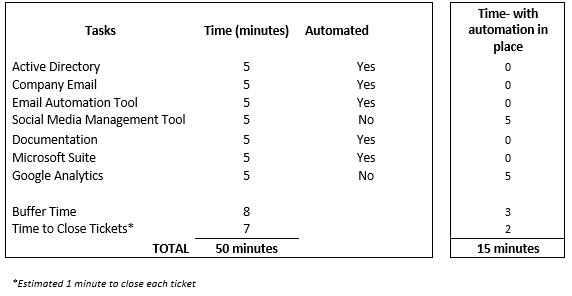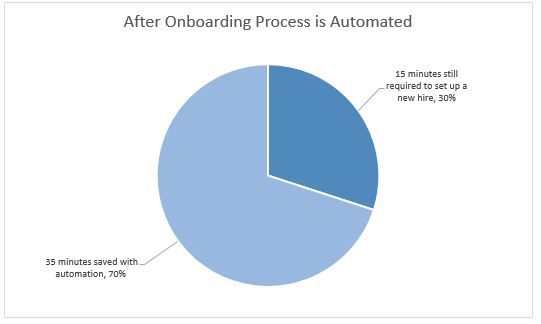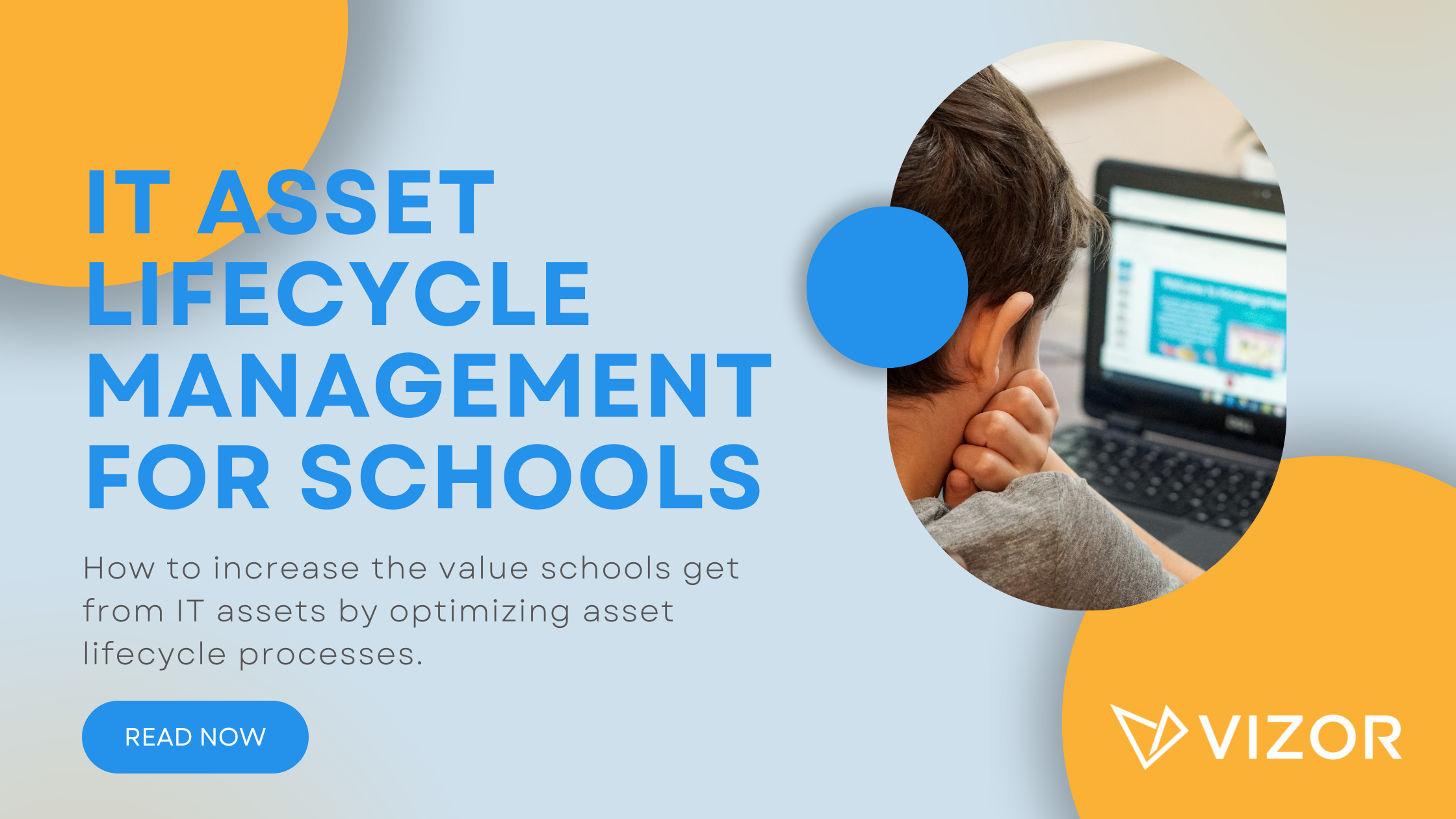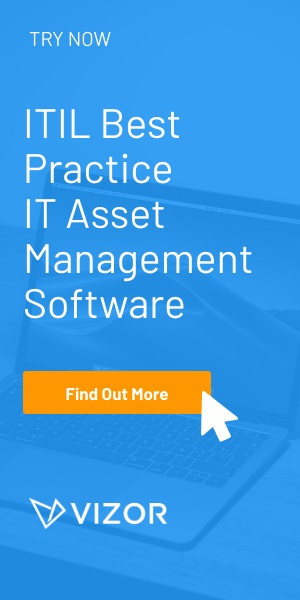The Perks of Automating the Onboarding Process
Organizations set up many processes to successfully onboard a new employee. Without a doubt, HR takes on most processes. However, there is also an IT department assisting with getting the new hire set up for work. The processes for both HR and IT vary from one organization to another. Then, they vary from one job position to another. Evidently, the larger the organization, the more resources are necessary. The fact is that HR usually has more procedures to follow and documentation to prepare for a larger organization. Similarly, IT would spend more time setting up the newcomer’s physical workspace, their computer, and their company account. This tedious process can take up quite some time. As an IT employee, what if you can reduce the time you spend onboarding new hires by half? Would you automate the processes you’re responsible for to save you time/resources?
Let’s go through a simple onboarding example of a new marketing recruit.
Organizations have specific IT tasks all new hires require, like the creation of an account in the active directory and the creation of a company email. As a result, the new marketing hire will require both. This individual may also require documentation from HR or IT about policies and procedures.
Every position has a set of specific tasks that will require attention as well. In this case, the new marketing hire will need access to the email automation tool, the social media management tool, Microsoft Office Suite, and Google Analytics. It’s important to note that you cannot have access to Google Analytics unless your email grants you access.
Putting the actual workspace setup aside as it is an inevitable task that you cannot automate, let’s take a closer look at each task listed above, determine the time it takes to execute and identify which ones you can automate.

Although the image sums everything up, let’s look into each task in more detail and the overall logic behind the numbers. For the simplicity of this example, 5 minutes seems like a fair estimate of how long it takes to complete each task.
Active Directory
Creating an account in the active directory is one task that is necessary to do for all new employees. Therefore, automating this process saves you at least 5 minutes onboarding every new employee- assuming no other accounts are in the same batch.
Company Email ted
Similar to the active directory, creating a company email is inevitable for new employees. For some organizations, this is an automated task. However, let’s assume you have nothing automated. It would take another 5 minutes to execute.
Email Automation Tool & Social Media Manager Tool
You can automate software if there’s a script already written for them. In some cases, the vendor provides you with the scripts and sometimes you can even find them online. Whether a software is on a cloud or on-premises, you cannot automate them all. As a result, this example includes one that can be automated and one that requires a ticket.
Documentation
After setting up the documentation to send out, you can distribute it with the click of a button.
Microsoft Office Suite
The deployment of software can be through a Group Policy or System Center Configuration Manager (SCCM). Virtualization technologies are also becoming more popular, making this task easier to automate.
Google Analytics
You must create a ticket to access to Google Analytics where it is only completed after the email is created. Although you cannot automate this task, the ticket can be sent automatically.
The table above includes 8 minutes of buffer time, assuming IT will not execute each task in exactly 5 minutes. An estimate of 1 minute to close each ticket is also considered. As a result, a sum of 50 minutes for IT to set up a new hire, without automation.
If the automated tasks are removed (5 minutes per automated task, for 4 tasks= 20 minutes), along with 1 minute buffer time and 1 minute closing ticket time per automated task (2 minutes per task, for 4 tasks= 8 minutes). It takes IT 22 minutes to set up a new employee if onboarding automation is set up. In other words, a reduction of 56% of the time taken to set up a new hire.

Evidently, automation takes time to set up and the time it saves you will vary depending on organization, position and even industry. But if you find yourself spending too much time onboarding new employees, consider the alternative tasks you could be completing. Here are some things IT can be doing instead of manually onboarding a new hire:
– Troubleshooting problems, issues, incidents
– Writing scripts
– Keeping users informed of their ticket status
– Creating reports/ building strategy
– Focus on security measures or even a forensic analysis/investigating a security breach (but let’s hope this doesn’t happen!)
Automating the onboarding process does primarily save you time; however, there are several other benefits that make setting up the automation worthwhile.
1) Process Documentation:
Without automation, an employee has to track processes manually, or it is not done at all. This risks not achieving a proper transfer of knowledge. Documentation of processes is also a key component of obtaining certain ISO certifications.
2) Sequential Ability:
The automation keeps track of any sequential tasks like setting up an email before granting Google Analytics, keeping things organized, and eliminating the chances of a step being forgotten.
3) Reduce Labor:
The automation helps save time for other departments like HR. In the example above, automatically sending out documentation meant HR did not have to access, print and distribute the documentation, or even just access and email.
4) Security Measure:
Although admins in the IT department should be the only ones to access the active directory that has sensitive information stored, it might be easier to delegate the task of opening an account to another technician. As a result, the technician would have access to sensitive information like employee information and PC information. The automation ensures data protection because it is done without an individual’s assistance.
5) Human Element:
There is no doubt that you have several tasks to do at once, therefore transferring from one task to another. It’s only normal that our ability, as humans, to change from one task to another is finite and can take a few minutes to adjust back to the task. Consequently, onboarding a new employee can take a lot more than 50 minutes. In addition, consider the number of incoming tickets for a new employee if part of the process is not automated. That can be overwhelming. Having the automation in place eliminates the distractions that might happen while setting up an account manually and it reduces the number of incoming tickets.
6) Take Advantage of Skills:
Even if you only save 7 working days out of the year from automating the onboarding process, what would you be doing instead? IT employees have unique skills to an organization and should be using them instead of setting up accounts for new employees.
The size of your organization is directly proportionate to the approximate number of new hires you onboard per year. For example, larger companies will hire more employees per year. For smaller businesses, however, the onboarding process can still be manual. But at what point should you start to consider automating your onboarding process? 5 new employees a year? 10 new employees? 50 new employees?
Automation is one of the perks for the onboarding processes for organizations that have new end users on a regular basis. Universities, high schools, or school boards have an influx of thousands of students several times a year. Hospitals receive dozens of interns all year long. Therefore, automating the onboarding process will benefit you based on the number of new employees per year, the job positions, the processes of your organization and your industry.
Taking all this into consideration, will you automate the onboarding process? Why or why not?
Do you already automate it? Let us know @vizorcloud
Need a IT Asset Management Tool?





